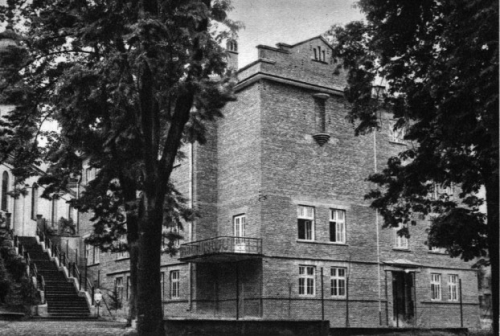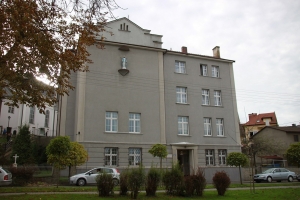I had a lot of female and male friends at school, I was working in an amateur theatre at school, but that wasn't decisive. At that time, my love for literature, especially dramatic literature and the theatre, seemed to me to be decisive.
John Paul II
The building, erected in 1935 right next to the parsonage, quickly became a new cultural centre in Wadowice. The main entrance to the Catholic House was located on the side of the Ogrodowa Street (today E. and K. Wojtyła Street), while the entrance from the side of the church led to a large theatre hall with 324 seats. Next to it, there was a cloakroom and a dressing room. Both the hosts and the growing local art community exploited the possibilities of the stage in the new facility.
The theatre plays have been staged here since 1936, under the direction of a middle school teacher, Fr. Edward Zacher. The parsonage scene was characterised by an ambitious repertoire that attracted local theatre enthusiasts. These were mainly religious-themed plays. In the school year 1935/36, the morning in the honour of St. Stanislaw Kostka and the celebration in the honour of the Virgin Mary were organised.
In 1936, Karol Wojtyła made his debut on the stage as a co-director of the „Nie-Boska komedia”, in which he played one of the main roles, Count Henry. In 1937, under the direction of Wadowice vicar and the catechist, Fr. Władysław Świżek, the youth staged the Passion Play several times, which was very well received in the city.
There were several theatre groups in Wadowice at that time, and their supervisors cooperated with each other. During the organisation of the staging of “The Apocalypse of St. John”, in which Karol Wojtyła played the role of St. John, Fr. E. Zacher borrowed some props from the carmelite father, Bogusław Woźnicki. He sent Lolek to bring a wonderful armchair to the stage, which used by a celebrant in a monastery church only on special occasions. Too bad that Karol, with the armchair on his head, was noticed by the then Prior of the Barefoot Carmelites, Fr. Gabriel Klimowski. Thinking that he was witnessing a theft of a valuable object, the prior ran after the alleged thief, crying out: ‘You rotten kid, where did you get it from!...’ Fortunately, the unpleasant situation was soon clarified and it was possible to begin the play. The last performance in the Catholic House, in which the young Wojtyła took part before leaving Wadowice, was “Judasz z Kariothu” by K. H. Rostworowski.
Currently, the theatre hall is used by the Holy Father John Paul II Family Home Museum as a conference room, cinema and exhibition hall.


